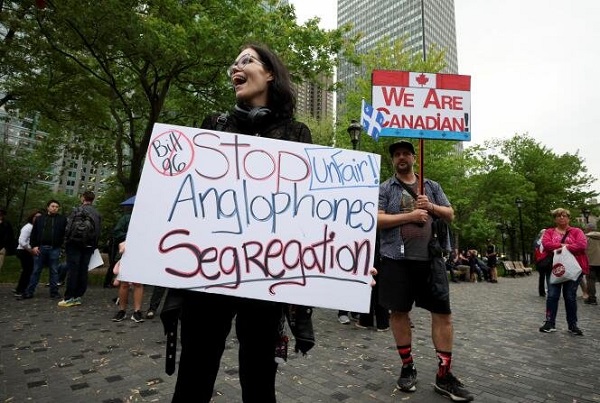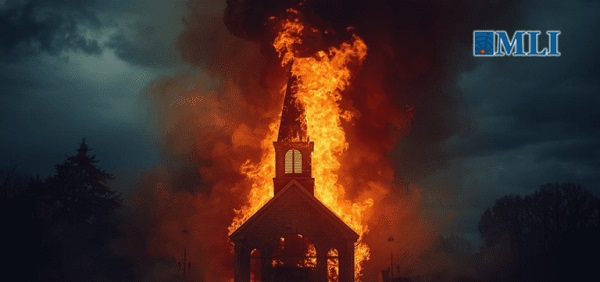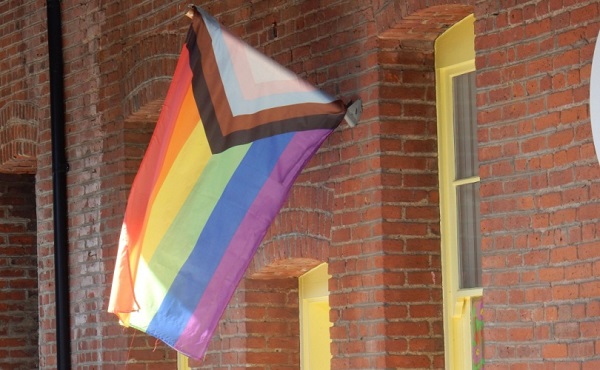Bruce Dowbiggin
Québec: Still Speaking In Tongues, Cashing Your Cheques

Lather. Rinse. Repeat. The cycle of Québec’s byzantine language politics continues. Nothing seems to change. The culture authoritarians propose. The anglos protest. More people make the decision to leave the province. The Québec-based prime minister takes off for Tofino.
The latest bagarre concerns a policy that has leaders of Québec’s English community worried they might not be entitled to health treatment in English. The purpose of this latest culture cleansing was, as always, to re-assert the primacy of French is the delivery of services. Because nothing works better than unworkable impositions to insoluble problems.
The language of the directive was, at best, inelegant. For instance, immigrants to the province are only eligible to receive health care in a language other than French for the first six months after their arrival. Also, says the document, a language other than French can only be used in healthcare settings when “health, public safety or the principles of natural justice require it,”— including in emergencies.
The directive also stipulates that members of “Quebec’s historic anglophone community” must provide a certificate proving their eligibility to attend English school in the province if they want to receive all medical services exclusively in English. (Wouldn’t wearing stars on their clothes suffice?)

Predictably the remaining Québec anglos, whose gullibility on language diktats knows no bounds, reacted in fear. For decades they’ve tried to be good little citoyens, sending their kids to French immersion, learning to order their smoked meat in the approved tongue, assuming settler guilt for winning at the Plains of Abraham. Voting Liberal. And what has it gotten them?
Trudeau Liberal stooge Anna Gainey tried to salve their feelings. “It is clear that the confusion and uncertainty created by the directive is likely to have adverse consequences that cannot be ignored,” she wrote. “Clarity is urgently needed. The choice of language should continue to belong to the patient.”
As you might expect, the tongue troopers denied any malign intent in their ongoing push to keep Québec a French enclave— even if that’s what the policy says. Three Québec ministers reached out to say the new directive does not restrict healthcare access for English speakers. “The government of Québec imposes absolutely no linguistic conditions in health care settings before providing health care in English to anyone who requests it,” they wrote in The Gazette.
In other words, take two pilules and call me in the morning. Plus cà change.
What’s most remarkable is that no one seems to acknowledge that this ongoing cleansing of the anglo fact in Quebec, a process launched by the election of René Levesque’s PQ in 1976, is a lingering 20th-century artifact, irrelevant in a current world where regional language and culture laws are subordinate to globalist commissars. In that world a unilingual Québec is a minnow that won’t last a minute.
As an example, this week’s X chat between its founder Elon Musk and Americans GOP candidate Donald Trump was seen as so threatening to world order that pencil-necked EU digital chief Thierry Breton warned Musk that, under EU laws, “X is obliged to ensure ‘all proportionate and effective mitigation measures are put in place regarding the amplification of harmful content’.”
In other words we are criminalizing speech we don’t like, and you might be charged. Breton’s concern was that “around 100 million X users in the EU” might be polluted by something other than his propaganda. (In fact, the chat had nearly a billion engagements worldwide.) Musk responded to Breton with a Tom Cruise line from Tropic Thunder that said, “Literally, fuck your own face!”

Meanwhile in Québec’s dreamland, the bunkered solitudes of traditional culture perpetuate their waltz over preserving a French culture abandoned centuries ago by the mother country. Hundreds of thousands of native Quebeckers have tired of this folly, leaving for other provinces and nations where the position of an apostrophe doesn’t bring down the weight of a government on you. An anglo rump conveniently remains to serve as punching bags for the autocrats in the National Assembly.
Equally preposterous is that Canada itself remains mired in this morass, incapable of entering the 21st century, because its eastern elites are petrified of admitting that Québec’s game is up. Principal among them is Justin Trudeau whose sovereign duty is preserving the status quo handed him by his father. That means the protection of Québec’s sweetheart deal under the equalization plan, wasting billions on a bilingual mandate in places where the most French thing is the fries and keeping police away from Québec’s sacred corporate sector.
Canada still has an explicitly separatist party in the federal parliament, sucking up federal funds while dreaming out loud about destroying the union. But they know that they’ll never have to go rogue in the current milieu. They’re protected by a double standard that allows them to take money from the rest of Canada (suck) while undermining the federation (blow).
While no one is anxious to see Canada rupture, patience has warn thin, says the Fraser Institute. “From 2007 and 2022, Albertans’ contributed $244.6 billion to the federal government in taxes and other payments in excess of the money Ottawa spent or transferred to Alberta — more than five times as much as was contributed (on net) by either British Columbians or Ontarians.
The other seven provinces, and most notably Québec, were net recipients of federalism, meaning the amount of revenue collected by the federal government in those provinces was exceeded by the amount of money spent or transferred by Ottawa back to the provinces.” All the while with Quebec attacking the energy sector that fuels their lucrative equalization hustle.
The persistent presence of the province among the takers is a feature, not a bug in the Trudeau master plan. In whatever language you say it, pandering to Québec and its linguistic fetish is unsustainable. But who will bell that cat when the current stalemate serves everyone in Ottawa?
Bruce Dowbiggin @dowbboy is the editor of Not The Public Broadcaster A two-time winner of the Gemini Award as Canada’s top television sports broadcaster, he’s a regular contributor to Sirius XM Canada Talks Ch. 167. His new book Deal With It: The Trades That Stunned The NHL And Changed hockey is now available on Amazon. Inexact Science: The Six Most Compelling Draft Years In NHL History, his previous book with his son Evan, was voted the seventh-best professional hockey book of all time by bookauthority.org . His 2004 book Money Players was voted sixth best on the same list, and is available via brucedowbigginbooks.ca.
Bruce Dowbiggin
NFL Ice Bowls Turn Down The Thermostat on Climate Change Hysteria

Oh, the weather outside was frightful. But the football was so delightful. Week 15 of the NFL season was a cryogenic success of snow and sub-zero temperatures. Here were the temperatures at game time this weekend.
Chicago: -11 degrees C.
Cincinnati: -12 degrees F.
Kansas City: -8 degrees C.
New England: -2 C (with an 87 percent chance of snow).
Philadelphia: -2 degrees C.
New York -1 degree C.
Pittsburgh: -7 degrees C.
For fans of NFL football none of this seemed out of character with late-season football. There are legendary games played in arctic conditions. The windchill for the 1967 Dallas/ Green Bay NFC championship was -25 C.
Chargers at Bengals: Jan. 10, 1982 (-24 C, feels like -39 C).
Seahawks at Vikings in NFC wild-card matchup Jan 10, 2016. -21 C with wind chill -25C
Dolphins at Chiefs: Jan. 13, 2024 (-4 degrees, feels like -27 degrees)
As recently as last week’s Bills win over the Bengals games are often played with drifts of snow on the field and the mercury bottoming out. While Canada’s Grey Cup game is played at the end of November it’s still had some brutal weather history of its own.
The point of this meteorology meandering is that, according to our good King Charles III and many other doomsday cultists the concept of snow and cold was supposed to be a figment of the past by now. For almost half a century Michael Mann and the climate prophets of IPCC have been predicting the end of snow and the onset of warmist floods and burning forests. They gambled trillions of the public’s dollars on the certainty that the public would buy computer modelling and data-distortion predicting doom.
For decades it has worked. The careers of people like critic Mark Steyn have been ruined, heretics declared and fortunes dissipated by the trust-fund fanatics who bankroll wackadoodles like Stephen Guilbeault, the convicted felon who Trudeau made Minister of the Environment. No matter how absurd or devious the source, it was a gospel that the fiery inferno was coming next Tuesday. But the weather has remained stubbornly resistant to Elizabeth May’s catechism of climate.

Yet, some dedicated climate advocates and their followers are finally changing their tune in the face of their own observation of lying liars like Al Gore and Greta Thunberg. The share of Americans who say climate scientists understand very well whether climate change is occurring decreased from 37 percent in 2021 to 32 percent this year. A similar October study from the University of Chicago’s Energy Policy Institute found that “belief in human-driven climate change declined overall” since 2017.
Reports the uber-liberal L.A. Times: “The unraveling of climate catastrophism got another jolt recently with the formal retraction of a high-profile 2024 study published in the journal Nature. That study — which had predicted a calamitous 62% decline in global economic output by 2100 if carbon emissions were not sufficiently reduced — was widely cited by transnational bodies and progressive political activists alike as justification for the pursuit of aggressive decarbonization.
But the authors withdrew the paper after peer reviewers discovered that flawed data had skewed the result. Without that data, the projected decline in output collapses to around 23%. Oops.”
Even stalwart media apologists for climate hysteria like the Times are starting to have doubts. Under the headline “The left’s climate panic is finally calming down” they describes “Erstwhile ardent climate-change evangelist Bill Gates published a remarkable blog post addressing climate leaders at the then-upcoming COP30 summit. Gates unloaded a blistering critique of what he called ‘the doomsday view of climate change,’ which he said is simply “wrong.”
Trump-besotted American Democrats seeking to soften their Woke image before the 2026 midterms are likewise carving out more moderate positions on climate “that could well deprive Republicans of a winning political issue with which to batter out-of-touch, climate-change-besotted Democrats. But for the sake of good governance, sound public policy and the prosperity of the median American citizen, it would be the best thing to happen in a decade.”
Sadly Canada under Mark Carney remains a staunch climate warrior. The removal of Guilbeault as federal Environmental Minister may have seemed a step toward sanity, but there is no hint that the billions of dollars from hidden money spigots will be closed down any time soon. The B.C. government’s acquiescence to the climate propaganda of Indigenous bands shows no sign of abating. Indeed, it is just ramping up in the land claims that threaten to make home ownership a thing of the past.

PM Mark Carney is a dedicated temperature fabulist going back to his days as governor of the Bank of England. His first fights in Canada were over taxing carbon and hobbling her energy industry. As we wrote in this November 2024 column, the certainty in which the Canadian Left revels is actually dividing, not uniting citizens.
So perhaps if enough citizens spend an afternoon shivering in the stands of a wintertime football game we might achieve a small piece of sanity and learn that that , while climate is always changing, it’s not worth the price we’ve paid this century.
Bruce Dowbiggin @dowbboy is the editor of Not The Public Broadcaster A two-time winner of the Gemini Award as Canada’s top television sports broadcaster, his 2025 book Deal With It: The Trades That Stunned The NHL And Changed hockey is now available on Amazon. Inexact Science: The Six Most Compelling Draft Years In NHL History, his previous book with his son Evan, was voted the seventh-best professional hockey book of all time by bookauthority.org . His new poetry collection In Other Words is available via brucedowbigginbooks.ca and on Kindle books.
Bruce Dowbiggin
Carney Hears A Who: Here Comes The Grinch

It’s a big day for the Who’s of Whoville. Mayor Augustus Maywho is now polling at 62 percent approval. Cindy Lou Who and Martha May Whovier can barely contain their trans-loving heart that finally the Pierre The Grinch is done.
Okay it’s not WhoVille. It’s Canada and it is leader Mark Carney who’s zooming in the polls against Pierre Poilievre. But it might as well be the real nation that Carney commands today. As 2025 comes to a conclusion Donald Trump seems the least of Whoville’s perils. For example:
The NDP government in B.C. has now declared that future legislation must be interpreted through the lens of the United Nations Declaration on the Rights of Indigenous Peoples. According to Chief Bent Knee (David Eby) this means that the province cannot act independently of the progressive diktats of Sudan, Nepal, Moldova and other international titans. Having been informed of Canada’s “genocidal” behaviour by Trudeau in the Rez Graves pantomime, the UN folk will no doubt look on Canadians as worthy of punishment.
The UNDRIP menace has been around since the days when Skippy Trudeau was wielding the mace in Parliament. On June 20, 2021 the federal government passed UNDRIP into law by a vote of 210 to 118. (The Liberals, NDP and Bloc all voted in favour.) The only party that opposed it were the Conservatives. In defence of those hapless boobs none of them voting yes ever expected a province to align itself with such legislation. That’s the Canadian way. Act on conscience. Retract on self preservation.

But on the heels of Eby’s unopposed capitulation to B.C.’s many “peoples” in recent land settlements, ones that threaten the legal right to properties of home owners, the wholesale framework for governing the province now will be determined by appeal to the UN.
The Carney crew — who act as though Canada’s indigenous communities are now equal partners in Confederation— assure Canadians that judicious lawyering by government savants has everything under control, but anyone trusting the Liberals after the past decade is in need of counselling.
The B.C. conundrum plays into another of the challenges (read: disasters) faced in B.C. by the Elbows Up brigade. Namely the much-heralded memorandum of understanding on energy policy between the feds and Alberta. Canadians were assured by Ottawa that this federal government sees pipelines as a priority, and getting Alberta’s product to tidewater as an urgent infrastructure need. Carney described the MOU as if it were a love-letter to the restless West. How is he going to get pipelines through to the B.C. coast when Eby and the indigenous said it was a no-go? Trust us, said Carney.

Before you could say Wetaskiwin dark clouds gathered on the deal. Smith took it in the ear from Alberta separatists for compromising anything to the feds. Carney, meanwhile, ran into the predictable roadblock from B.C. Eby talked of maybe allowing pipelines in the future, but the ban on shipping off the province’s shoreline was verboten.
To test the resilience of the MOU the federal Conservatives (remember them?) put forward a motion to build the pipeline from Alberta to the B.C. coast. Even though the motion used the same language of the MOU between Danielle Smith and Mark Carney, the Liberals and their hand maidens defeated the motion. Carney himself abstained because, hey look at that shiny object.
Immediately the Trudeaupian Deflection Shield was employed. Here’s Liberal Indigenous Service minister and proud Cree operative Mandy Gull Masty “Today’s motion that’s being put on the floor is not a no vote for the MOU. It’s a no vote against the Conservatives playing games and creating optics and wasting parliamentary time when they should be voting on things that are way more important.”
Robert Fife, the highly rated G&M scribbler who just won some big award, led the media pack, “Conservatives persist with cute legislative tricks, while the government tries to run a country.” Run a country? Into the ground?
Let’s not forget the $1.5 billion bloviators at CBC. They, too, say the vote is a big loss for the Tories. “It risks putting them offside, what is a very top priority and frankly, was considered a big win for Alberta Premier Danielle Smith.’” said Janyce McGregor. Here’s Martin Patriquin on one of the Ceeb’s endless panels. “It’s embarrassing, man. I don’t see any sort of political advantage to what happened today.”
Embarrassing? The Libs have committed to re-building gas pipelines in Ukraine, even as they stall on developing pipelines in Canada. Luckily CBC washrooms have no mirrors. And there’s always Donald Trump to deflect from the pantomimes of Canadians Laurentian debating club.
Here, CTV hair-and-teeth Scott Reid is nursing a Reuters poll that has Trump’s approval at historic lows of 36 percent. Reuters is a firm that predicted Kamala winning the presidency. Until she didn’t on Nov.4. Meanwhile Rasmussen, which correctly had Trump ahead the entire campaign, has his current approval at 44 percent while the RCP average is 43.9.
But corrupt data to make Trump seem odious is no sin in WhoVille Ottawa. Keep feeding the Karens bad data. At least Canadians have their beloved healthcare to fall back on. Or maybe their beloved MAID. A Saskatchewan woman suffering from parathyroid disease has revealed that she is considering assisted suicide, because she cannot get the surgery she needs.
“Jolene Van Alstine, from Saskatchewan, has extreme bone pain, nausea and vomiting. She requires surgery to remove a remaining parathyroid, but no surgeons in the province are able to perform the operation. In order to be referred to another province for the operation, Van Alstine must first be seen by an endocrinologist, yet no Saskatchewan endocrinologists are currently accepting new patients.
The pain has become so unbearable that she has been approved for Canada’s euthanasia and assisted suicide program, with the ending of her life scheduled to take place on 7 January 2026.”
Well. Happy New Year, Canada. May no one offer you MAID in the next twelve months.
Bruce Dowbiggin @dowbboy is the editor of Not The Public Broadcaster A two-time winner of the Gemini Award as Canada’s top television sports broadcaster, his new book Deal With It: The Trades That Stunned The NHL And Changed hockey is now available on Amazon. Inexact Science: The Six Most Compelling Draft Years In NHL History, his previous book with his son Evan, was voted the seventh-best professional hockey book of all time by bookauthority.org . His 2004 book Money Players was voted sixth best on the same list, and is available via brucedowbigginbooks.ca.
-

 Alberta19 hours ago
Alberta19 hours agoDanielle Smith slams Skate Canada for stopping events in Alberta over ban on men in women’s sports
-

 Health1 day ago
Health1 day agoSaskatchewan woman approved for euthanasia urged to seek medical help in Canada rather than US
-

 Indigenous1 day ago
Indigenous1 day agoResidential school burials controversy continues to fuel wave of church arsons, new data suggests
-

 International1 day ago
International1 day agoFBI didn’t think it had cause to raid Trump but DOJ did it anyway
-

 Health2 days ago
Health2 days agoCanadian gov’t considers sharing census data on gender-confused children
-

 Crime21 hours ago
Crime21 hours agoThe Uncomfortable Demographics of Islamist Bloodshed—and Why “Islamophobia” Deflection Increases the Threat
-

 Energy1 day ago
Energy1 day agoLiberals Twisted Themselves Into Pretzels Over Their Own Pipeline MOU
-

 Business2 days ago
Business2 days agoCOP30 finally admits what resource workers already knew: prosperity and lower emissions must go hand in hand




